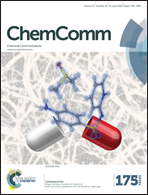Probing the correlations between the defects in metal–organic frameworks and their catalytic activity by an epoxide ring-opening reaction†
Abstract
Seven Zr/Hf-based MOFs with different degrees of defects were obtained by modulating the synthetic conditions. The number of missing linkers in these MOFs was calculated based on potentiometric acid–base titration. The number of defects was found to correlate quantitatively with the catalytic activity of UiO-type MOFs for an acid-catalyzed epoxide ring-opening reaction. More importantly, we were able to identify a MOF with inherent defective Zr6 nodes, which showed great activity and regio-selectivity for the epoxide ring-opening reaction.


 Please wait while we load your content...
Please wait while we load your content...